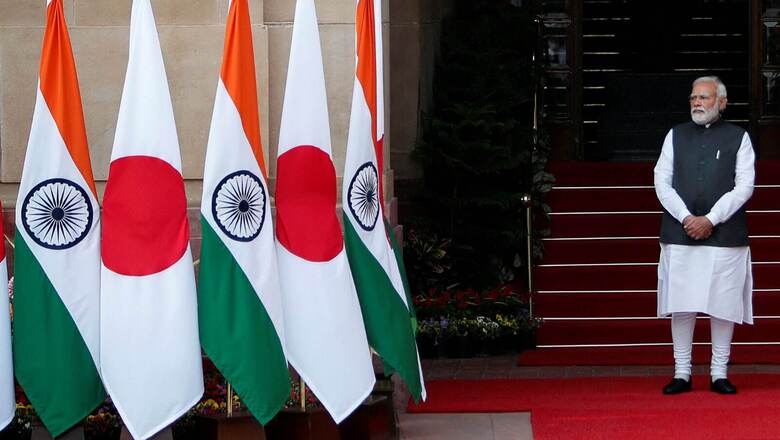
views
Even as the bloody struggle between Putin’s Russia and Ukraine continues to command the attention of the world, a major geopolitical shift is afoot half a world away. As American power in Asia fades, allies and adversaries are scrambling to define the new Asian order. Japan has moved to sign defence pacts with Australia and the United Kingdom while South Korea has made positive noises about joining the Quad. Not to be left behind, Beijing made waves in already troubled waters by announcing a secretive security agreement with the Solomon Islands. These developments make clear that the churning waters of the Indo-Pacific are sweeping away American power and giving way to Asia 2.0.
To begin with, Tokyo has been on a diplomatic blitz through the region. Scarcely four months after announcing a long-awaited defence pact with Australia, Japan has found another willing partner in the United Kingdom. Taken together, these two Reciprocal Access Agreements (RAAs) aim to make the militaries of the three nations, as Australian premier Scott Morrison put it, “completely interoperable”. At their core, these agreements will allow defence forces to access each other’s bases, carry out joint exercises, resupply each other and undertake combined responses to natural disasters.
Equally significant was the recently concluded Korean Presidential election, which saw the once disgraced conservatives fight their way back to power. South Korea’s new President, Yoon Suk-Yeol, has signalled his desire to work closely with the United States and cease his nation’s feud with Japan. Most significantly, President Yoon made clear that his administration would “positively review joining” the Quad should an invitation be extended to South Korea. Even if a bid for formal membership were to prove a bridge too far, the new dispensation in Seoul is likely to join the Quad’s efforts in fighting climate change, securing open waterways for trade and guaranteeing regional stability.
Taken together, these changes reflect a new order: Asia 2.0. The region may finally have turned the page on the old “hub and spoke” model that defined the American-led security order that took hold after World War II. Previously, major players like Japan, Australia and South Korea each enjoyed close political and security ties with America without building similar ties with each other. This created a strategic dependence that placed Washington in a unique and highly advantageous position as the only power that could feasibly mobilise a coalition in Asia to achieve its interests.
But now, while Washington remains the region’s leading power, its relative decline vis-a-vis China has forced it to acknowledge that American leadership will need to be replaced by a genuinely multilateral coalition of powers. The recent agreements between Japan, Australia and the UK as well as South Korea’s willingness to join the Quad reflect a new and networked Asia 2.0 where nations are slowly but surely moving past their dependence on American power.
In India’s Interest
For New Delhi, the rise of a genuinely multipolar Asia 2.0 in its backyard has long been at the top of its geopolitical wish list. India’s preference for strategic autonomy was on display as a fierce national debate raged over India’s need for Russian arms even as Moscow’s tanks rolled into Ukraine. While the rationale for achieving autonomy remains much the same, the means of achieving it have transformed. In the decades after Independence, India’s focus on the mammoth task of achieving domestic transformation led it towards a foreign policy that shunned overt alignments, maintained regional stability and stayed out of great power conflicts. As it tried to navigate the treacherous tides of international politics, India’s policy preference was to lean away from the changes and churn generated by great power competition.
However, India at 75 is faced with an entirely different opportunity in Asia 2.0: strategic autonomy requires New Delhi to lean in and acquire options in the form of credible and capable partnerships. For India to transform its economy, modernise its military and fight existential challenges like climate change, it will need to build closer alignments, shape rules of the game through institutions like the Quad and entrench itself as a leading state as American power fades. Should India succeed in becoming a leading state in the new order, few powers could feasibly exploit dependencies to push New Delhi to conform to particular policy positions. Only by seizing the rare opportunity thrown up by America’s decline and shaping, rather than simply navigating, the tides of international politics can India ensure genuine autonomy in Asia 2.0.
ALSO READ | Taking Ties to New Heights: Japan and India Join Hands in the Strategic Andaman and Nicobar Islands
Asia’s defence buildup offers a view into the opportunities thrown up by this new order. With both Japan and South Korea ramping up defence expenditures in their efforts to build bases of national power independent of Washington, New Delhi will find a range of willing defence partners in the region. By expanding cooperation on the development of defence technologies and enhancing understanding of each party’s defence needs, New Delhi can cultivate a host of new defence partners, reduce its legacy dependencies on powers like Russia and entrench itself as a leading Asian state. Should India manage to increase defence interoperability with two of Asia’s leading militaries, its position as a key security provider would ensure New Delhi’s prestige, power and position in Asia 2.0.
India also needs Asia 2.0 to hammer out an approach to the omnipresent China challenge. Beijing’s bid to dominate everything from regional security to emerging technologies will necessitate a focused response across numerous domains. India may find that the going will be easier if New Delhi forms part of a coalition that leverages the unique strengths of its members. China’s recent defence pact with the Solomon Islands starkly illustrates this reality. Even as the ink dries on the agreement, analyses of its potential implications are flying thick and fast. While much of the hand-wringing surrounding the agreement has to do with the potential establishment of a permanent Chinese base in the South Pacific, the pact’s significance is undeniable. Beijing’s diplomatic coup allows it a foothold in Australia’s backyard and a perch from which it can observe the Quad’s military activities. Given that China now possesses the largest fleet in the world and, seemingly, the intention to deploy it to far flung corners, the Quad’s shared vision of a free and open Indo-Pacific will rest on the shoulders of this new Asian order. The recently concluded defence agreements between Japan and Australia will enhance the ability of their militaries to jointly patrol and if necessary, defend, Pacific waters. From New Delhi’s perch in the Indian Ocean, this more robust security order can only be to the good.
As Russian actions in Europe and Chinese expansion in Asia overturn old certainties in international politics, India has a chance to shape the tides of geopolitics rather than simply go with the flow. It is an opportunity New Delhi would be wise not to pass up.
The author is a research associate, strategic studies programme, Observer Research Foundation (ORF). The views expressed in this article are those of the author and do not represent the stand of this publication.
Read all the Latest Opinions here


















Comments
0 comment